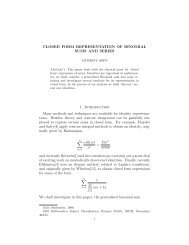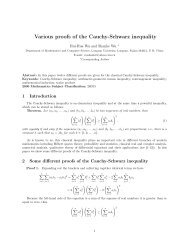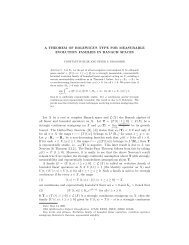(1) I - Research Group in Mathematical Inequalities and Applications
(1) I - Research Group in Mathematical Inequalities and Applications
(1) I - Research Group in Mathematical Inequalities and Applications
Create successful ePaper yourself
Turn your PDF publications into a flip-book with our unique Google optimized e-Paper software.
NOTE ON MATHIEU’S INEQUALITY<br />
BAI-NI GUO<br />
Abstract. In this note, us<strong>in</strong>g the <strong>in</strong>tegral expression of Mathieu’s series <strong>and</strong> <strong>in</strong>equalities for<br />
Fourier s<strong>in</strong>e transformation, we establish some new <strong>in</strong>equalities for Mathieu’s series.<br />
The Mathieu’s series is first def<strong>in</strong>ed <strong>in</strong> [7] as<br />
∞�<br />
S(r) =<br />
1. Introduction<br />
n=1<br />
2n<br />
(n2 + r2 , r > 0. (1)<br />
) 2<br />
In 1890, Mathieu [7] conjectured that S(r) < 1/r 2 . In [6], Makai proved<br />
1<br />
r 2 + 1/2<br />
The <strong>in</strong>tegral expression of Mathieu’s series (1) was given <strong>in</strong> [3, 4] by<br />
S(r) = 1<br />
r<br />
� ∞<br />
0<br />
1<br />
< S(r) < . (2)<br />
r2 x s<strong>in</strong>(rx)<br />
e x −1<br />
Recently, H. Alzer, J. L. Brenner <strong>and</strong> O. G. Ruehr <strong>in</strong> [1] obta<strong>in</strong>ed<br />
dx. (3)<br />
1<br />
x2 1<br />
< S(x) <<br />
+ 1/(2ζ(3)) x2 , (4)<br />
+ 1/6<br />
where ζ denots the zeta function.<br />
The study of Mathieu’s series <strong>and</strong> its <strong>in</strong>equalities has a rich literature, many <strong>in</strong>terest<strong>in</strong>g ref<strong>in</strong>ements<br />
<strong>and</strong> extensions of Mathieu’s <strong>in</strong>equality can be found <strong>in</strong> [1]–[9].<br />
In this paper, us<strong>in</strong>g the <strong>in</strong>tegral expression (3) of Mathieu’s series <strong>and</strong> <strong>in</strong>equalities for Fourier<br />
s<strong>in</strong>e transformation, we will establish some new <strong>in</strong>equalities for Mathieu’s series.<br />
2. Ma<strong>in</strong> Results<br />
We first calculate the <strong>in</strong>tegral of Mathieu’s series on (0, +∞).<br />
Proposition 1. The <strong>in</strong>tegral of the Mathieu’s series on the <strong>in</strong>f<strong>in</strong>ity <strong>in</strong>terval (0, +∞)<br />
� ∞<br />
0<br />
S(r) dr = π3<br />
. (5)<br />
12<br />
1991 Mathematics Subject Classification. Primary 33E20, 40A30; Secondary 26A48, 26D15.<br />
Key words <strong>and</strong> phrases. Inequality, <strong>in</strong>tegral expression, Mathieu’s series, Fourier s<strong>in</strong>e transformation.<br />
The author was supported <strong>in</strong> part by NSF of Henan Prov<strong>in</strong>ce (no. 004051800), SF for Pure <strong>Research</strong> of the<br />
Education Committee of Henan Prov<strong>in</strong>ce (no. 1999110004), <strong>and</strong> Doctor Fund of Jiaozuo Institute of Technology,<br />
The People’s Republic of Ch<strong>in</strong>a.<br />
This paper was typeset us<strong>in</strong>g AMS-LATEX.<br />
1
2 BAI-NI GUO<br />
Proof. It is well-known [11, p. 269 <strong>and</strong> p. 332] that, for any µ > 0, we have<br />
� ∞<br />
0<br />
x<br />
ex π2<br />
dx =<br />
−1 6 ,<br />
� ∞<br />
0<br />
s<strong>in</strong> x<br />
x<br />
dx =<br />
� ∞<br />
0<br />
s<strong>in</strong>(µx)<br />
x<br />
dx = π<br />
. (6)<br />
2<br />
Therefore, from formula (3), the <strong>in</strong>tegral of Mathieu’s series S(r) on the <strong>in</strong>terval (0, +∞) equals<br />
� ∞ � ∞<br />
x<br />
S(r) dr =<br />
ex �� ∞ �<br />
s<strong>in</strong>(rx)<br />
dr dx<br />
−1 r<br />
0<br />
= π<br />
2<br />
0<br />
� ∞<br />
= π3<br />
12 .<br />
The proof of Proposition 1 is complete.<br />
0<br />
0<br />
x<br />
e x −1 dx<br />
Corollary 1. The value ζ(3) of the zeta function ζ at po<strong>in</strong>t 3 satisfies<br />
ζ(3) < π4<br />
. (7)<br />
72<br />
Proof. Integrat<strong>in</strong>g the left h<strong>and</strong> side of <strong>in</strong>equalities (4) on the <strong>in</strong>terval (0, +∞) yields<br />
π �<br />
2ζ(3) =<br />
2<br />
� ∞<br />
This completes the proof of Corollary 1.<br />
0<br />
dx<br />
x 2 + 1/(2ζ(3)) <<br />
� ∞<br />
0<br />
S(x) dx = π3<br />
12 .<br />
In order to obta<strong>in</strong> our ma<strong>in</strong> result, the follow<strong>in</strong>g lemma is necessary.<br />
Lemma 1 ([2, pp. 89–90]). If f ∈ L([0, ∞)) with lim f(t) = 0, then<br />
t→∞<br />
∞�<br />
(−1) k � ∞<br />
∞�<br />
f(kπ) < f(t) cos t dt < (−1) k f(kπ), (8)<br />
∞�<br />
(−1) k f<br />
k=0<br />
k=1<br />
��<br />
k + 1<br />
� �<br />
π <<br />
2<br />
Our ma<strong>in</strong> result is as follows.<br />
Theorem 1. If r > 0, then<br />
π<br />
r3 ∞� (−1) k�k + 1<br />
�<br />
� 2 � <<br />
π/r − 1<br />
k=0<br />
Proof. S<strong>in</strong>ce<br />
exp �� k + 1<br />
2<br />
<strong>and</strong>, for fixed r > 0, let f(t) =<br />
∞�<br />
n=1<br />
0<br />
� ∞<br />
0<br />
k=0<br />
f(t) s<strong>in</strong> t dt < f(0) +<br />
2n<br />
(n2 + r2 1<br />
<<br />
) 2 r2 �<br />
1 + π<br />
r<br />
S(r) = 1<br />
� ∞<br />
r 0<br />
= 1<br />
r3 � ∞<br />
0<br />
x s<strong>in</strong>(rx)<br />
ex −1 dx<br />
t s<strong>in</strong> t<br />
e t/r −1 dt,<br />
t<br />
et/r , then f ∈ L([0, ∞)),<br />
−1<br />
lim f(t) = lim<br />
t→∞ t→∞<br />
∞�<br />
(−1) k f<br />
k=0<br />
∞�<br />
k=0<br />
��<br />
k + 1<br />
� �<br />
π . (9)<br />
2<br />
(−1) k�k + 1<br />
� �<br />
� 2 � . (10)<br />
π/r − 1<br />
exp �� k + 1<br />
2<br />
(11)<br />
t<br />
et/r = 0, (12)<br />
−1
therefore, us<strong>in</strong>g <strong>in</strong>equalities <strong>in</strong> (9), we have<br />
1<br />
r2 ∞� (−1) k�k + 1<br />
�<br />
2 π/r<br />
� � < S(r) <<br />
π/r − 1 1<br />
r2 �<br />
∞�<br />
1 +<br />
k=0<br />
The proof is complete.<br />
Open Problem. Let<br />
exp �� k + 1<br />
2<br />
NOTE ON MATHIEU’S INEQUALITY 3<br />
S(r, t) =<br />
∞�<br />
n=1<br />
k=0<br />
where t > 0 <strong>and</strong> r > 0.<br />
Can one get an <strong>in</strong>tegral expression of S(r, t) similar to (3)?<br />
(−1) k�k + 1<br />
� �<br />
2 π/r<br />
� � .<br />
π/r − 1<br />
exp �� k + 1<br />
2<br />
2n<br />
(n2 + r2 , (13)<br />
) t+1<br />
References<br />
[1] H. Alzer, J. L. Brenner, <strong>and</strong> O. G. Ruehr, On Mathieu’s <strong>in</strong>equality, J. Math. Anal. Appl. 218 (1998), 607–610.<br />
[2] P. S. Bullen, A Dictionary of <strong>Inequalities</strong>, Addison Wesley Longman Limited, 1998.<br />
∞�<br />
[3] A. Elbert, Asymptotic expansion <strong>and</strong> cont<strong>in</strong>ued fraction for Mathieu’s series, Period. Math. Hungar. 13 (1982),<br />
no. 1, 1–8.<br />
[4] O. E. Emersleben, Über die Reihe k(k<br />
k=1<br />
2 + c2 ) −2 , Math. Ann. 125 (1952), 165–171.<br />
[5] Ji-Chang Kuang, Applied <strong>Inequalities</strong>, 2nd edition, Hunan Education Press, Changsha City, Ch<strong>in</strong>a, 1993.<br />
(Ch<strong>in</strong>ese)<br />
[6] E. Makai, On the <strong>in</strong>equality of Mathieu, Publ. Math. Debrecen 5 (1957), 204–205.<br />
[7] E. Mathieu, Traité de physique mathématique, VI–VII: Théorie de l’élasticité des corps solides, Gau-<br />
thier-Villars, Paris, 1890.<br />
[8] D. S. Mitr<strong>in</strong>ović, Analytic <strong>Inequalities</strong>, Spr<strong>in</strong>ger, New York, 1970.<br />
[9] D. S. Mitr<strong>in</strong>ović, J. E. Pečarić, <strong>and</strong> A. M. F<strong>in</strong>k, Classical <strong>and</strong> New <strong>Inequalities</strong> <strong>in</strong> Analysis, Kluwer Academic<br />
Publishers, Dordrecht, 1993.<br />
[10] D. C. Russell, A note on Mathieu’s <strong>in</strong>equality, Æquationes Mathematicæ, 36 (1988), 294–302.<br />
[11] Feng-Wu Zou, Zhong-Zhu Liu, <strong>and</strong> Huai-Chun Zhou, Collection of Integral Formulae (Jifen Biao Huibian),<br />
Space Navigation Press, Beij<strong>in</strong>g, Ch<strong>in</strong>a, 1992. (Ch<strong>in</strong>ese)<br />
Department of Mathematics, Jiaozuo Institute of Technology, Jiaozuo City, Henan 454000, The<br />
People’s Republic of Ch<strong>in</strong>a



![[2], Diaz and Metcalf es - Research Group in Mathematical ...](https://img.yumpu.com/8975823/1/190x245/2-diaz-and-metcalf-es-research-group-in-mathematical-.jpg?quality=85)


